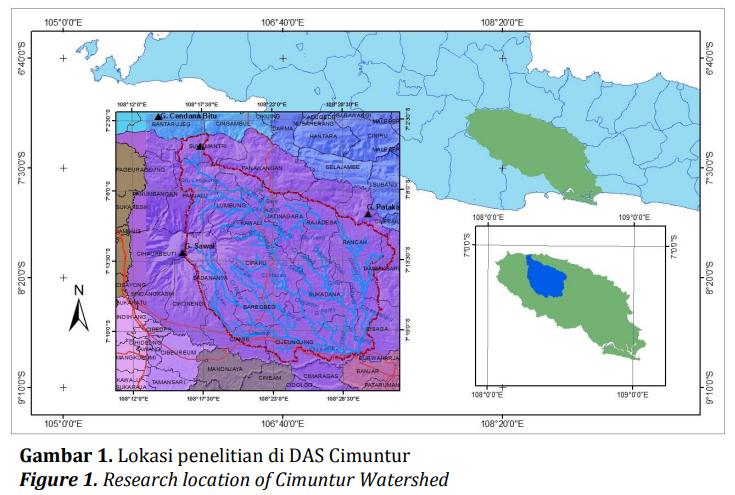Hydrological Responses of Agroforestry System Application which is Not Based on Land Suitability, A Case Study in Cimuntur Watershed

Land use in a watershed should consider land capability and watershed carrying capacity so that the land can optimally. Agroforestry is a land use system that not only aims to generate income for the people but also to maintain hydrological conditions of a watershed. This research aims to evaluate the hydrological responses due to the application of agroforestry system on several land use pattern that has been changed. There are three steps in the analysis: (1) Assessment on land use planning (RTRW), (2) Land use suitability classification for agroforestry system, and (3) Development of scenarios for suitable land use of agroforestry system for hydrological function. The results of this study show that the application of agroforestry system of woody plant (i.e. sengon), fruit plant (i.e. Nephelium lappaceum), annual crops (i.e. clove, coconut, Parkia speciosa and banana), perennial crops (i.e. cardamom, and banana), and seasonal crops (i.e. cassava) on unsuitable land use gives the lowers on Coefficient of River Regime (KRS), specific discharge, Run off Coefficient (C) and Total Dissolve Sediment (TDS). This agroforestry system can be applied on several land use pattern that has been changed, because this system not only aims to generate income for the people but also to the maintain hydrological condition of a watershed
Abbas, T., Nabi, G., Boota, M. W., Hussain, F., Faisal, M., Ahsan, H., … Lahore, T. (2015). Impacts of Landuse Changes on Runoff Generation in Simly, Lahore 27(4), 3185–3191.
Arifin, H. S. (2009). Analisis lanskap agroforestri: konsep, metode, dan pengelolaan agroforestri skala lanskap dengan studi kasus Indonesia, Filipina, Laos, Thailand, dan Vietnam. Bogor: IPB Press.
Arnold, J., Allen, P., Volk, M., Williams, J., & Bosch, D. (2010). Assessment of different representations of spatial variability on SWAT model performance. Transactions of the ASABE, 53(5), 1433-1443.
Atangana, A., Khasa, D., Chang, S., & Degrande, A. (2014a). The benefits and services of agroforestry systems Tropical Agroforestry (pp. 151-240): Springer.
Atangana, A., Khasa, D., Chang, S., & Degrande, A. (2014b). Definitions and classification of agroforestry systems Tropical Agroforestry (pp. 35-47): Springer.
Bahrun, A. (2012). Kajian ekofisiologi tanaman semusim penyusun agroforestri pada beberapa zona agroklimat di DAS Ciliwung Hulu. (Disertasi), Institut Pertanian Bogor, Bogor.
Bajocco, S., De Angelis, A., Perini, L., Ferrara, A., & Salvati, L. (2012). The impact of Land Use/Land Cover Changes on land degradation dynamics: A Mediterranean case study. Environmental Management, 49(5), 980–989.
Chu, H. J., Liu, C. Y., & Wang, C. K. (2013). Identifying the relationships between water quality and land cover changes in the tseng-wen reservoir watershed of Taiwan. International Journal of Environmental Research and Public Health, 10(2), 478–489.
Douglas-Mankin, K., Srinivasan, R., & Arnold, J. (2010). Soil and Water Assessment Tool (SWAT) model: Current developments and applications. Transactions of the ASABE, 53(5), 1423-1431.
Emilda, A. (2010). Dampak Perubahan Penggunaan Lahan terhadap Respon Hidrologi DAS Cisadane Hulu. (Tesis). Institut Pertanian Bogor, Bogor.
Junaidi, E. (2013). Peranan penerapan agroforestri terhadap hasil air DAS Cisadane. Jurnal Penelitian Agroforestry, 1(1), 41-53.
Junaidi, E. (2009). Kajian Berbagai Alternatif Perencanaan Pengelolaan DAS Cisadane Menggunakan Model SWAT. (Tesis). Institut Pertanian Bogor, Bogor.
Kehutanan. (2009). Penetapan Daerah Aliran Sungai (DAS) Prioritas Dalam Rangka Rencana Pembangunan Jangka Menengah (RPJM) Tahun 2010-2014. (SK. 328/Menhut-II/2009). Republik Indonesia: Kementerian Kehutanan.
Mathevet, T., Michel, C., Andréassian, V., & Perrin, C. (2008). A bounded version of the Nash-Sutcliffe criterion for better model assessment on large sets of basins, 307, 211–219.
Mahmoud, S. H., & Alazba, A. A. (2015). Hydrological response to land cover changes and human activities in arid regions using a geographic information system and remote sensing. PLoS ONE, 10(4), 1–20.
Olivera, F., Valenzuela, M., Srinivasan, R., Choi, J., Cho, H., Koka, S., & Agrawal, A. (2006). ARCGIS‐SWAT: A geodata model and GIS interface for SWAT1. JAWRA Journal of the American Water Resources Association, 42(2), 295-309.
Paimin, Sukresno, & Purwanto. (2006). Sidik cepat degradasi sub Daerah Aliran Sungai. Bogor: Puslit Hutan dan Konservasi Alam, Badan Litbang Kehutanan.
Ragosta, G., Evensen, C., Atwill, E. R., Walker, M., Ticktin, T., Asquith, A., & Tate, K. W. (2010). Causal connections between water quality and land use in a rural tropical island watershed : Rural tropical island watershed analysis. EcoHealth, 7(1), 105– 113. https://doi.org/10.1007/s10393-010-0299- 9.
Santhi, C., Arnold, J. G., Williams, J. R., Dugas, W. A., Srinivasan, R., & Hauck, L. M. (2001). Validation of the swat model on a large RWER basin with point and nonpoint sources1: Wiley Online Library.
Sanudin, (2006). Analisis dan Strategi Pemanfaatan Ruang di Kabupaten Ciamis, Jawa Barat. (Tesis). Institut Pertanian Bogor, Bogor.
Senaviratne, A., Udawatta, R., Baffaut, C., Anderson, S., Jose, S., Poppy, L., . . . Soolanayakanahally, R. (2013). Apex simulation: environmental benefits of agroforestry buffers on corn-soybean watersheds [Conference poster]. Paper presented at the Proceedings of the 13th North American Agroforestry Conference, June 19-21, 2013, Charlottetown, Prince Edward Island, Canada.
Smith, J., Pearce, B. D., & Wolfe, M. S. (2013). Reconciling productivity with protection of the environment: Is temperate agroforestry the answer? Renewable Agriculture and Food Systems, 28(01), 80-92.
Suradiputra, I. N. N., Sartono, D., & Ilman, M. (2005). Krisis Air di Inonesia. In A. W. M. M. S. Sarwintyas Prahastuti (Ed.), (pp. 19-32). Jakarta: Lembaga Ilmu Pengetahuan Indonesia.
Susetyaningsih, A. (2012). Pengaturan Penggunaan Lahan Di Daerah Hulu DAS Cimanuk Sebagai Upaya Optimalisasi Pemanfaatan Sumberdaya Air. Jurnal Konstruksi, 10(1), 1-8.
Udawatta, R., Jose, S., & Garrett, H. (2015). A Paired watershed Evaluation of Agroforestry effects on Water Quality on a Corn/Soybean Rotation. Paper presented at the EGU General Assembly Conference Abstracts.
Wibawa, W. D. (2010). Disain Pengelolaan Lahan Berkelanjutan berbasis Tanaman Hortikultura Tahunan di DAS Ciliwung Hulu. (Disertasi). Institut Pertanian Bogor, Bogor.
Wood, A., & Mayer, J. (2006). Sustainable Land Management: Challenges, Opportunities, And Trade-Offs: Washington, DC: World Bank.
Yustika, R., Tarigan, S., Hidayat, Y., & Sudadi, U. (2012). Simulasi Manajemen Lahan di DAS Ciliwung Hulu Menggunakan Model SWAT. Informatika Pertanian, 21(2), 71-79.

